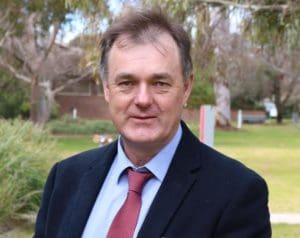
Is it time Australia’s peak sheep and wool bodies are reborn into one body?

WoolProducers president Ed Storey
AUSTRALIA’S sheep and wool producers within three months could be considering potential models for merging their two peak bodies into a single entity.
Peak wool grower body WoolProducers Australia is keen to consult with its State Farming Organisation members in the next three months on models for merging with Sheep Producers Australia, formerly the Sheepmeat Council of Australia.
Mr Storey gave an update on the WPA-SPA negotiations at the Victorian Farmers Federation Livestock Group annual general meeting in Bendigo on Wednesday. He told Sheep Central today the two peak bodies have had very constructive meetings in recent months.
“We are now at a point where there are a couple of options before us as a group and WoolProducers Australia has resolved that we are very keen to consult with our State Farming Organisation members about some of the key features and functions that they want from their peak council in the future.
“Do they want it bigger and to cost more, or do they want a lean and more efficient model – what are the key functions they want?,” he said.
“That will guide WoolProducers’ thinking on how we progress from here.”
Mr Storey believed the process would probably involve establishing a new entity that made the best use of scarce resources.
“There are lots of voices in the world, but it is a sheep after all, the sheep that produces a couple of products (meat and wool), so there is that view.
“But both sides of the equation need to be represented strongly and we need to come up with a model that can do that,” he said.
“We want to conduct good strong and meaningful consultation within the next three months.”
State Farming Organisations support merger talks

Sheep Producers Australia chair Chris Mirams.
SPA chairman Chris Mirams said discussions around merging with WPA had been happening on an “on again off gain” basis for years.
“I guess that’s because on the surface it seems to be very appealing, on the basis of ‘why would you have two bodies dealing with the one animal’ and there is potential for a duplication of effort.
“It is maybe not the most efficient method of spending ley payers’ and tax payers’ monies supporting two institutions if it could successfully be done by one,” he said.
“SPA and WoolProducers recognise that and the State Farming Organisations are very enthusiastic about merger talks and we recognise that too.”
He said he and Mr Storey with the SPA and WPA chief executive officers have formed a taskforce independently chaired by Andrew Henderson. The taskforce includes members of both boards and have been talking about the challenges, opportunities, benefits and potential models “that might move forward to creating a representative body that advantages the functions of both.”
Mr Mirams said the taskforce had reported its interim findings to the SPA and WPA boards, which had also met socially.
“The role of the taskforce members hasn’t finished yet, they are still progressing towards their final recommendations.
“So both boards are working towards that in good faith and looking forward to the next communication from the taskforce.”
Mr Mirams said the taskforce has created a number of models and governance structures for the boards and the industry to consider. The two boards have requested the taskforce prepare its final recommendations as soon as possible.
“We’ve invested the funds, done the due diligence, we must be very close to getting a final report from the taskforce, I would have thought.”
Mr Mirams said he expected the benefits of a merger would be efficiencies in less duplication, but these are to be quantified with science and data.
“Often SPA and WPA are at the same committee meetings and we’re working together really strongly on the sheep sustainability framework.
“But if we were one, would be working on it as one, rather than duplicating some effort,” he said.
“There are things that we do that they don’t do and things that they do that we don’t do, but there are certainly some areas where there is some overlap.”



Just get on with that ASAP. We need a united organisation in place to negotiate our position under the new MOU.
This is great news. We currently have two peak industry councils that have the same membership and speak to the same audience about the same animal.
Our industry needs one strong and independent peak industry council that can represent Australia’s 30,000 sheep producers on all sheep issues. A united sheep industry council can then deliver clear and concise messaging to our politicians, industry regulators and industry service providers.